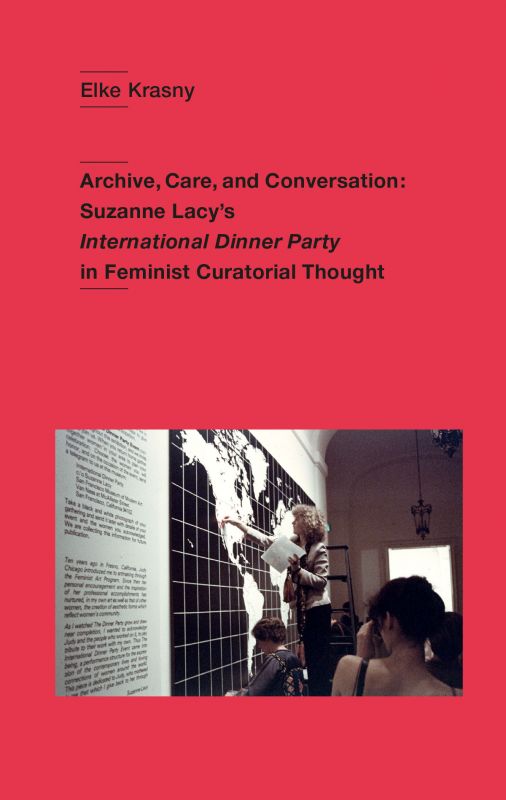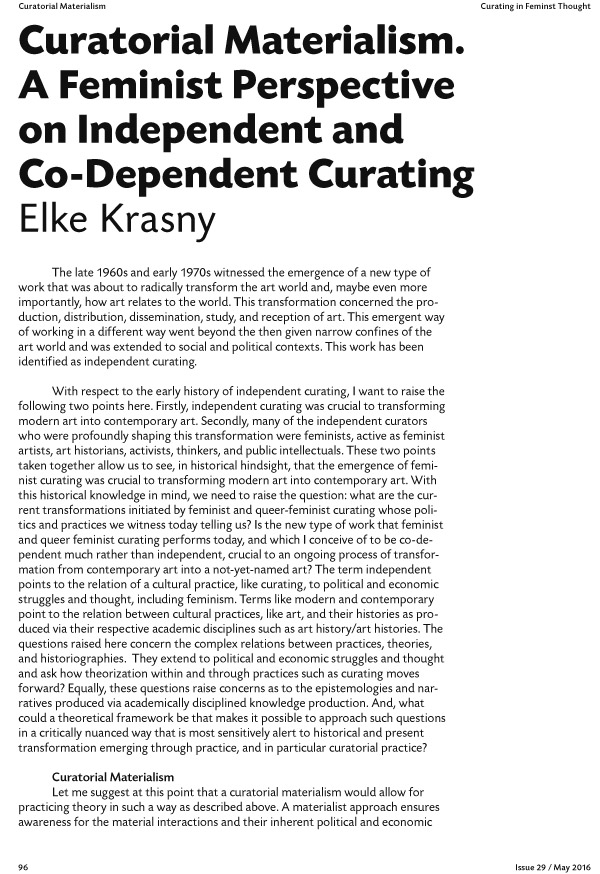Krasny, Elke. ‘Architecture.’ 2020
Krasny, Elke. ‘Architecture.’ In Connectedness. An Incomplete Encyclopedia of the Anthropocene, edited by Marianne Krogh, 52-55, Copenhagen: Strandberg Publishing, 2020.
Krasny, Elke. ‘Architecture.’ In Connectedness. An Incomplete Encyclopedia of the Anthropocene, edited by Marianne Krogh, 52-55, Copenhagen: Strandberg Publishing, 2020.
What happens when feminist activism turns art making into social practice? What happens when feminist conversations, at once joyful, contentious, conflictual, and generative, are being cared for through curatorial practice that mobilizes the archives of ephemeral, art-enabled conversations? Feminist artists of the 1970s concerned with developing a radical critique of heteropatriarchy used dinner parties and conversations for artistic exploration. The Dinner Party by artist Judy Chicago is the best-known example harnessing the representational power of a dinner party. Much less known is The International Dinner Party by Suzanne Lacy, who invited “sisters” around the world to hold dinner parties simultaneously on March 14, 1979 to create “a network of women-acknowledging-women”. This exemplar of feminist social practice rooted in activism is the starting point for this book. Feminist curatorial thought connects the archive of The International Dinner Party conversations to emerging archives of present-day conversations addressing feminist and queer-feminist politics tied to different histories, ideologies, and geographies. The present-day archives of conversations include Aktion Arkiv (addressing migratory realities in Sweden), radical practices of collective care (addressing caring labour conditions transnationally), Red Min(e)d (addressing the post-Yugoslav context), and Queering Yerevan (addressing local-diasporic Armenian realities).
Order here (US) or here (Germany)
Or Download a LowRes PDF here.
ISBN 9798645807054

Krasny, Elke. ‘Architecture and Care.’ In Critical Care. Architecture and Urbanism for a Broken Planet, edited by Fitz, Angelika, Elke Krasny, and Architekturzentrum Wien, 33-43. Boston: MIT Press, 2019.
Architecture in its broadest sense provides shelter indispensable tothe continuation of human life and survival. This is evidently a form of care. Yet historically, architecture has not been considered a form of caring labor. Despite this fundamental function of archi-tecture to provide protection for humans from sun, wind, snow orrain, and to give the support necessary for maintaining the vitalfunctions of everyday living, the idea of the architect is linked toautonomy and independent genius rather than connectedness,dependency, social reproduction and care giving. While the idea of the architect being an artist, traditionally gendered male, has beenmost influential over centuries, the notion of the architect being acarer, traditionally gendered female and considered menial laborperformed by racialized others, has been completely absent fromthe discourse on architecture.
Krasny, Elke. ‘Divided We Share: On the Ethics and Politics of Public Space.’ In Shared Cities Atlas. Post-socialist Cities and Active Citizenship in Central and Eastern Europe, edited by Helena Doudová, 126-133. Rotterdam: nai010, 2019.
#unteilbar was the motto of a mass rally that took place on 13 October 2018 in Berlin. #indivisible was used to demonstrate unity against the surge of right-wing populism and against racism and xenophobia. In German, just like in English, un- is a negative prefix which means not. The suffix bar translates into the English -able or -ible meaning capable of being or able to be done. The centre syllable teil interests me the most here. The verb teilen has two meanings: to share and to divide. Public space is both shared and divided, and people are divided over how to share and divide it.
Krasny, Elke. ‘Queering Yerevan: A Feminist Materialist Analysis.’ In Queering Visual Cultures, edited by Subashish Bhattacherjee, 15-41. Montreal: Universitas.
Edited by Angelika Fitz, Elke Krasny and Architekturzentrum Wien
Published by The MIT Press
How architecture and urbanism can help to care for and repair a broken planet: essays and illustrated case studies.
Today, architecture and urbanism are capital-centric, speculation-driven, and investment-dominated. Many cannot afford housing. Austerity measures have taken a disastrous toll on public infrastructures. The climate crisis has rendered the planet vulnerable, even uninhabitable. This book offers an alternative vision in architecture and urbanism that focuses on caring for a broken planet. Rooted in a radical care perspective that always starts from the given, in the midst of things, this edited collection of essays and illustrated case studies documents ideas and practices from an extraordinarily diverse group of contributors.
Focusing on the three crisis areas of economy, ecology, and labor, the book describes projects including village reconstruction in China; irrigation in Spain; community land trust in Puerto Rico; revitalization of modernist public housing in France; new alliances in informal settlements in Nairobi; and the redevelopment of traditional building methods in flood areas in Pakistan. Essays consider such topics as ethical architecture, land policy, creative ecologies, diverse economies, caring communities, and the exploitation of labor. Taken together, these case studies and essays provide evidence that architecture and urbanism have the capacity to make the planet livable, again.
Essays by Mauro Baracco, Jane da Mosto, Lionel Devlieger, Angelika Fitz, Hélène Frichot, Katherine Gibson, Mauro Gil-Fournier Esquerra, Valeria Graziano, Gabu Heindl, Ann Hill, Elke Krasny, Lisa Law, Ligia Nobre, Meike Schalk, Linda Tegg, Ana Carolina Tonetti, Kim Trogal, Joan Tronto, Anna Tsing, Theresa Williamson, Louise Wright Case studies aaa atelier d’architecture autogérée, Ayuntamiento BCN, Kashef Mahboob Chowdhury/Urbana, Cíclica [Space.Community.Ecology] + CAVAA arquitectes, Care+Repair Tandems Vienna (including Gabu Heindl, Zissis Kotionis + Phoebe Giannisi, rotor, Meike Schalk, Cristian Stefanescu, Rosario Talevi and many others), Colectivo 720, Estudio Teddy Cruz + Fonna Forman, EAHR Emergency Architecture & Human Rights, Fideicomiso de la Tierra del Caño Martín Peña CLT, Anna Heringer, Anupama Kundoo, KDI Kounkuey Design Initiative, Lacaton & Vassal, Yasmeen Lari, muf architecture/art, Paulo Mendes da Rocha + MMBB, RUF Rural Urban Framework, Studio Vlay Streeruwitz, De Vylder Vinck Taillieu, ZUsammenKUNFT Berlin
Copublished with Architekturzentrum Wien
–––––––––––––––––––––––––––––––––––
Release date: May 2019
Series: The MIT Press
Paperback: 300 pages
Publisher: The MIT Press
Language: English
ISBN-10: 0262536838
ISBN-13: 978-0262536837
Product Dimensions: 6.5 x 9.2 inches
The second half of the 1990s witnessed a conversational turn in curating. Ranging from small discussion circles to blockbuster- like marathons, conversations abounded in museums, art galleries and exhibitions. The very same period witnessed an increasing number of publications dedicated to museum studies, including the history and theory of curating. Whereas the questions raised by museum scholarship were very much concerned with exhibitions, the same cannot be said about conversations. That conversations are neglected subjects in museum histories betrays a long history of the feminisation of conversation as an intellectual, artistic and political practice, whose signifi cance my essay attempts to understand and restore while keeping in mind the gendered and other politics that pervade contemporary curatorial practice.
Elke Krasny: ‘The Salon Model: The Conversational Complex’ in: Feminism and Art History Now. Radical Critiques of Theory and Practice, edited by Victoria Horne and Lara Perry, I.B. Tauris 2017, p.147-163
‘This exciting book… is bound to expand the field of feminist art history, curatorial and museum studies in significant and lasting ways, and to generate extensive debate and further scholarship.’ — Helena Reckitt, Senior Lecturer in Curating, Goldsmiths, University of London
–––––––––––––––––––––––––––––––––––
Release date: 26 Jun 2017
Hardback: 288 pages
Publisher: I.B. Tourist
Language: English
ISBN-13: 978-1784533250
ISBN-10: 1784533254
Product Dimensions: 216 x 138
Krasny, Elke. ‘For Us Art is Work. In♀Akt – International Action Community of Women Artists.’ In All-Women Art Spaces in Europe in the long 1970s, edited by Agata Jakuba and
Katy Deepwell, 96-118. Liverpool: Liverpool University Press, 2017.
They used the artistic strategy of appropriating found objects to support compositions based on formal seriality. In 1978 they used bedsheets and continued with handkerchiefs in 1984. The bedsheets represented domestic labour, sexuality, intimacy, power and religion. Again, this became a method of democratic art making, navigating both collective formation and individual expression. And they chose objects with domestic references which seemed particularly meaningful for feminist appropriations.
Caption: Leintücher – Künstlinge & Findlinge [Bedsheets – Artlings & Foundlings], bedsheet installation, Steirischer Herbst, invitation, 1979, IntAkt Archive Vienna
Krasny, Elke. ‘Exposed: The Politics of Infrastructure in VALIE EXPORT’s Transparent Space.’ Third Text volume 31, 2017: 133-146.
On 16 May 2001 the renowned feminist artist and occasional curator VALIE EXPORT took part in the opening ceremony celebrating the completion of Transparent Space, her only public artwork in Vienna. A large room-sized cube made of glass, the work is installed in one of the arches formed by the viaduct of an elevated urban railway. The ambiguity of this piece is underscored by its adoption of three separate names: Transparenter Raum (Transparent Space), Kubus EXPORT (Cube EXPORT) and Frauenbru¨ cke (Women’s Bridge). Kubus EXPORT alludes to the artist’s own name, selected as a ‘logo in capital letters’ in 1967 in order to resist the system of patrilineage as well as to express her adoption of a radical feminist stance under patriarchal art-world conditions. Today, the artist’s brand name is inscribed onto the cube’s surface while Women’s Bridge is relegated to the printed brochure occasioned by the opening ceremony.The latter title evokes the language of second-wave feminism as well as its collective activist spirit, yet the artwork itself leaves open the question as to whether women cross the bridge together, have built the bridge collaboratively, work towards having the bridge named after them, or a necessary combination of all three.
by Elke Krasny, published May 2016 in: On Curating / Issue 29, CURATING in feminist thought
